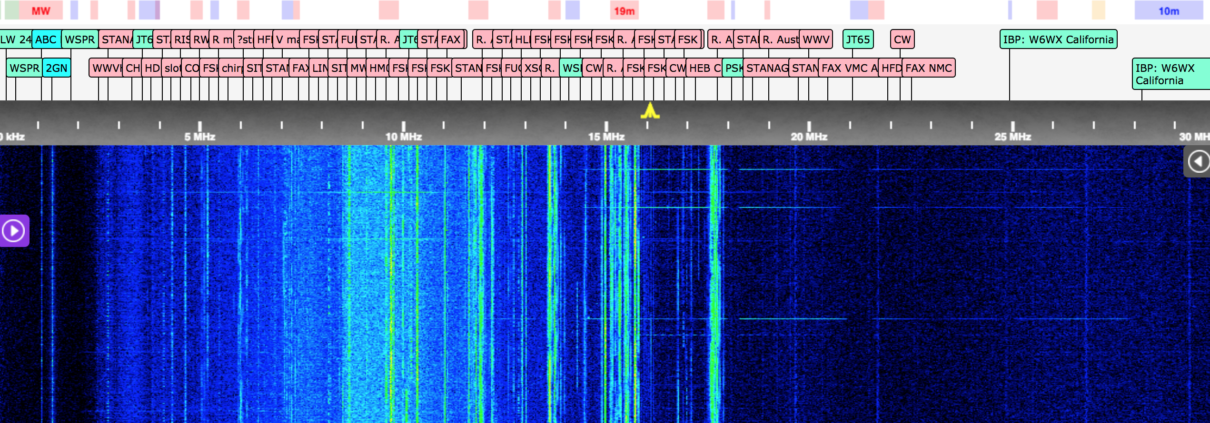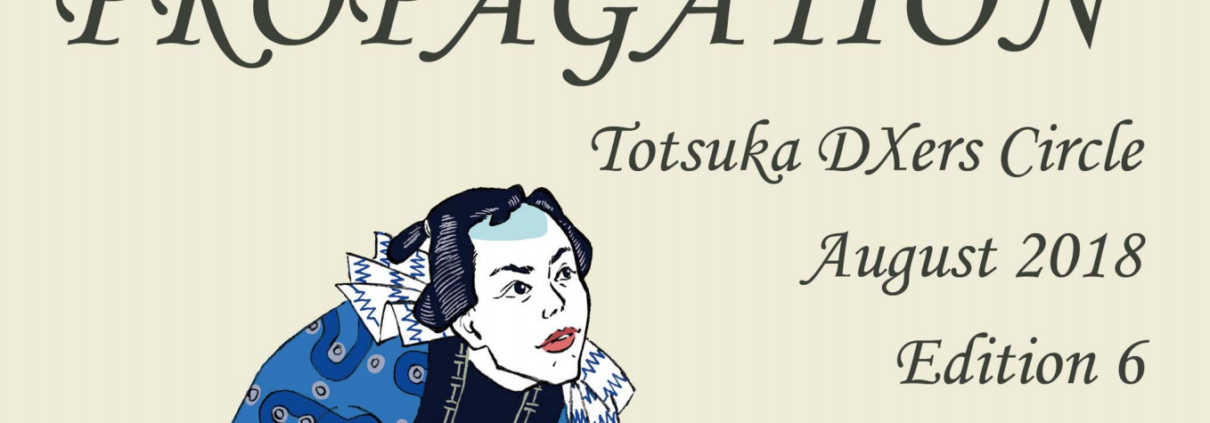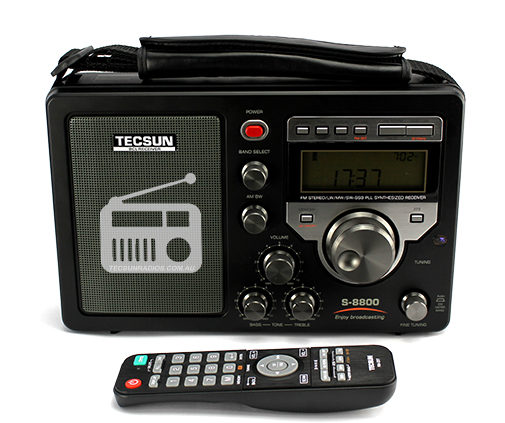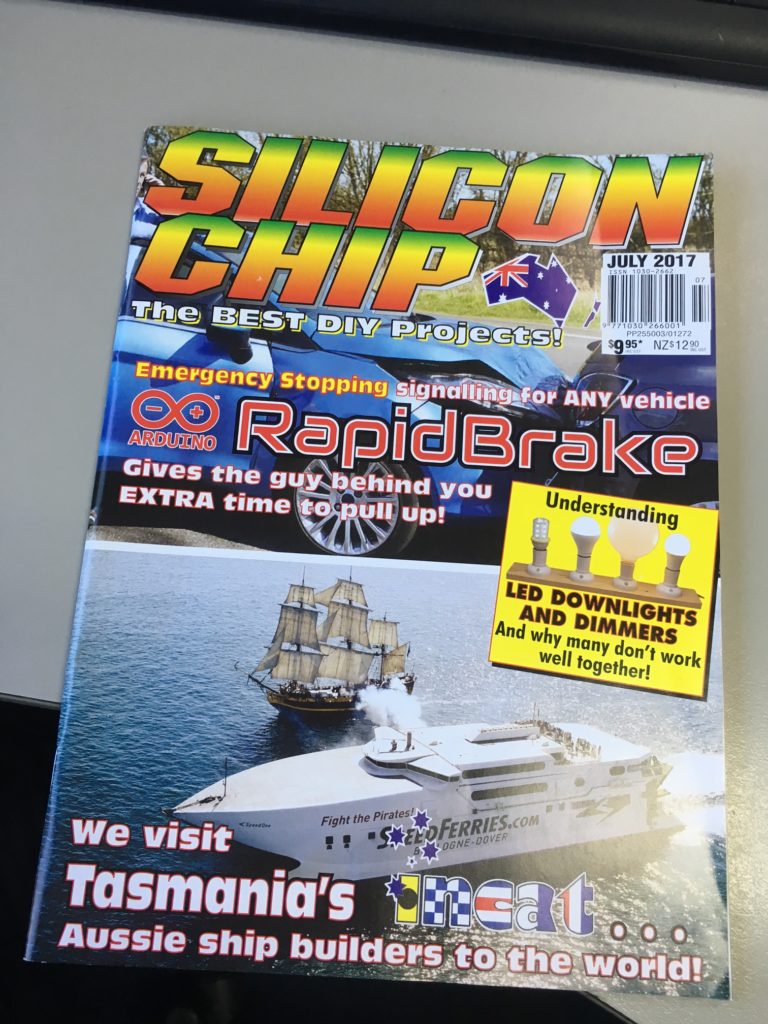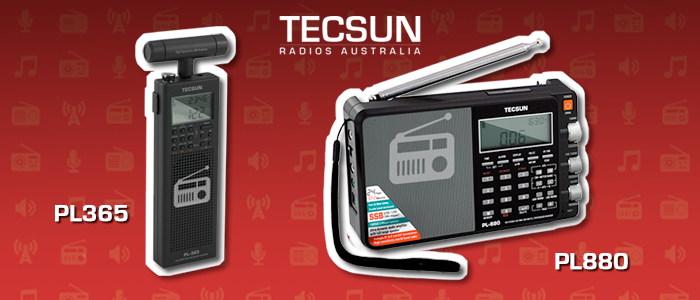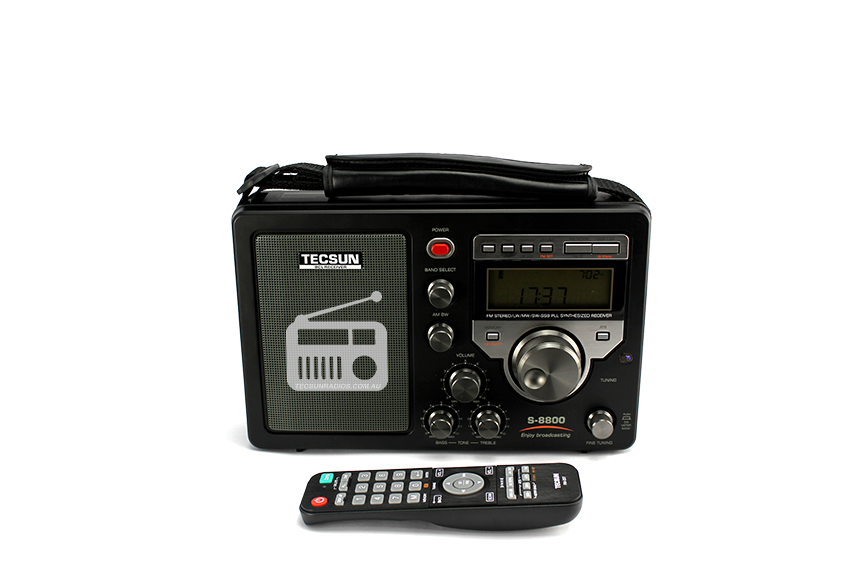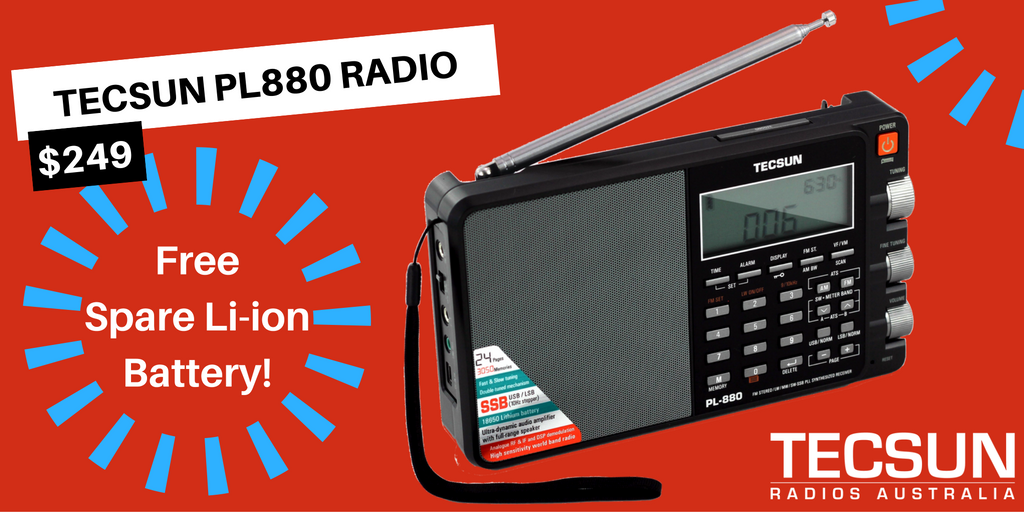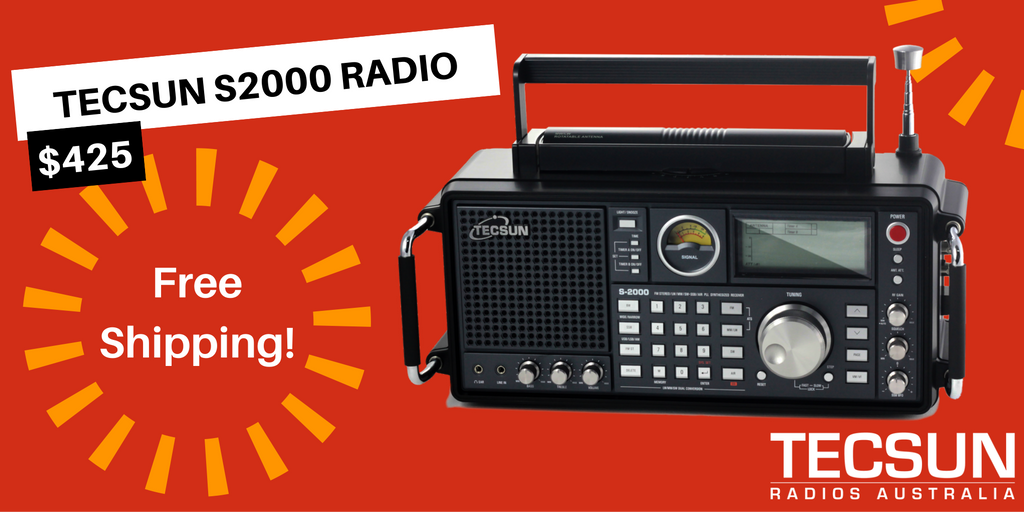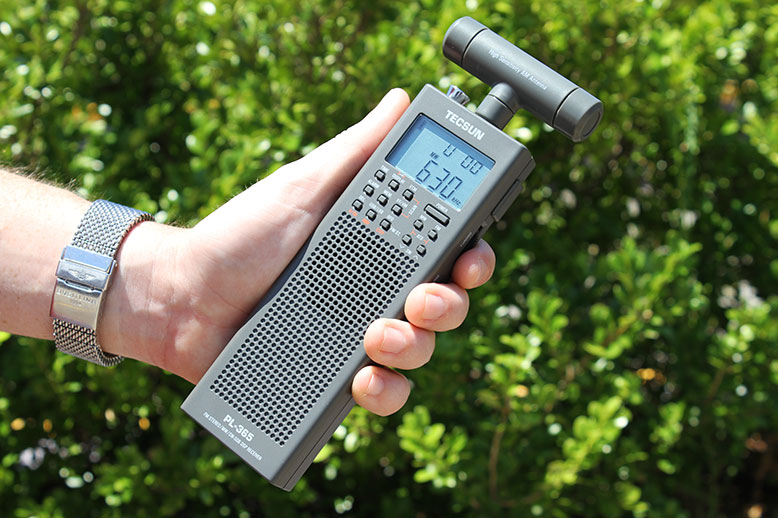Posts
Tecsun Radios Australia has set up a Software defined radio (receiver) in Araluen, a small rural community in NSW, Australia. It’s a quiet location for radio “noise”, far away from high density population and the accompanying RF noise generated.
You can listen to the Tecsun Radios Australia SDR here.
The SDR itself is called a “KiwiSDR” and is a commercially available unit, costing around $500. The Kiwi SDR compared to others has 2 advantages: (1) it allows the user to observe the entire shortwave spectrum in one screen, and (2) it can easily be connected to the internet to allow remote operation.
Other SDRs only receive a narrow portion of the radio spectrum, and require extra equipment to connect to the internet.
With the Kiwi SDR, it is easy to remotely identify that a signal exists from the “waterfall” display and then accurately tune and receive it.
The SDR is connected to two separate trapped HF vertical antennas. Each antenna is fed via common mode chokes ,one at the antenna end, and one at the equipment end of each cable run. These 2 antennas are then fed to an HF signal combiner. This provides some degree of antenna redundancy. The HF combiner feeds a 1:1 50 ohm transformer to isolate the KiwiSDR power supply ground from the antenna ground.
The antennas have been located as far away from man made noise sources as possible, and are fed with 75 ohm quad shield cable. Careful attention has also been paid to the grounding of the antenna.
Because the location is remote and in a bushfire affected area, mains power is supplemented by battery backup. The 5 volt power supply required by the KiwiSDR is a linear power supply that has a built in switching delay of 0.5 seconds, to ensure stable reset after power failure. We have been unable to surce a UPS with low RFI footprint for this application.
Connectivity to the www is achieved via a Skylink Ka band satellite link.
The Kiwi SDR can be used to receive AM, AM Narrow, USB, LSB, weatherfax, CW (Morse Code) and DRM signals.
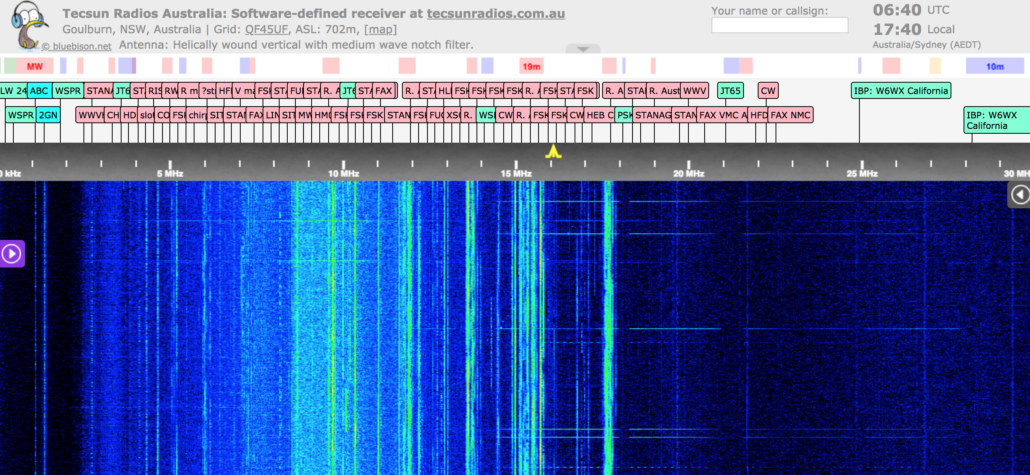
The Tecsun Radios SDR ‘waterfall’
You can listen to the Tecsun Radios Australia SDR here.
Or, simply logon to the SDR (go to http://kiwisdr.com/public/ for a worldwide list), select an SDR located close to the transmission source you’d like to listen to, select the appropriate mode and the desired frequency.
Have you tuned into the Tecsun Radios SDR?
Tell us in the comments below where you’re tuning in from and what you listened to!
At Tecsun Radios Australia, we’re a bunch of amateur radio enthusiasts ourselves, and AMSAT’s satellite launch on December 4 (Australian time) “Fox1 Cliff” has inspired us to join forces with the volunteers at AMSAT who build and launch Amateur Radio Satellites.
The Tecsun S-8800 has been a long time coming to the Australian market so we’re very excited that Silicon Chip Magazine has featured this great new addition to our range of radios in their most recent July 2017 magazine!
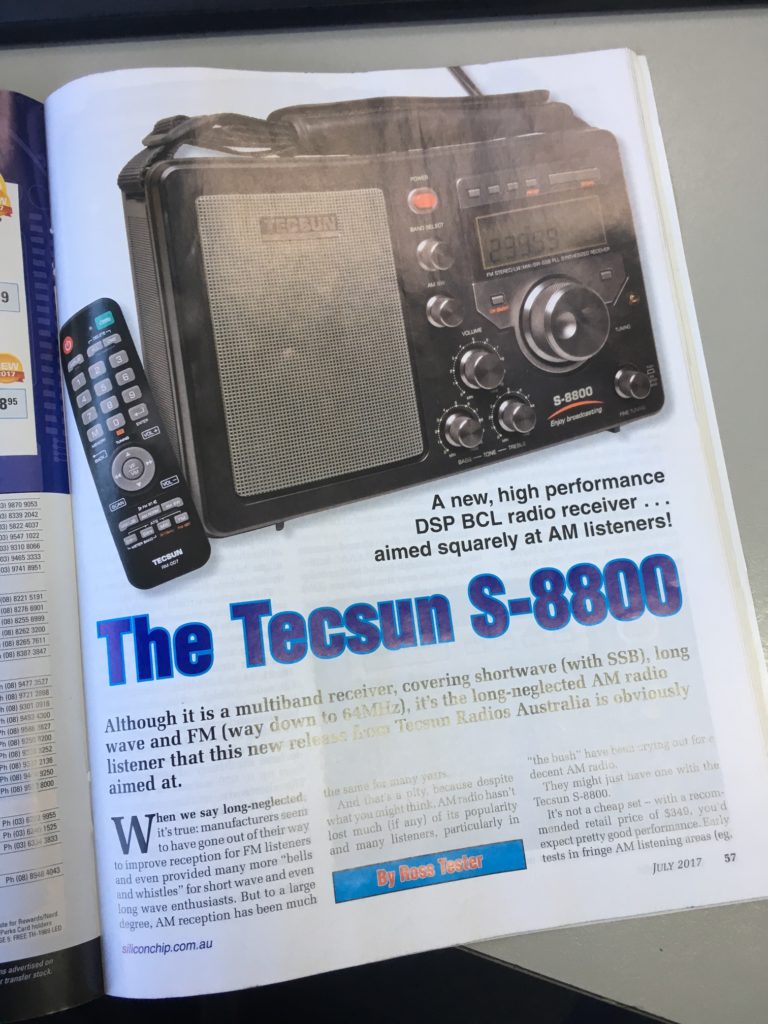
The Tecsun S-8800 review is on Page 57 of the July 2017 issue of Silicon Chip Magazine!
Here are some of the great things they had to say about the P-8800.
“If you live in, or go “bush” and want a radio that will let you keep listening where other radios have given up, or if you’re a city resident who wants to give DX listening a go, try the Tecsun S-8800.”
– Silicon Chip Magazine
“The S-8800 is right up there, even exceeding many higher-priced sets in its ability to not only resolve distant stations but to maintain them at an enjoyable level.”
– Silicon Chip Magazine
“The shortwave section covers just above the broadcast band (1.711MHz) through to almost 30MHz (actually 29.999MHz and with its single sideband plus AM reception, along with fine tuning, you’ll be pulling in stations that you didn’t know existed!”
– Silicon Chip Magazine
And the Silicon Chip team aren’t the only ones excited about this great new addition to the Tecsun family of radios. Here you can read Garry Cratt’s full review here, and watch the video demonstration!
“Although the frequency range is stated as 520-1620kHz (when the receiver is set to 9kHz spacing), it can be extended by setting the receiver to 10kHz spacing and then it will be possible to tune 520-1710kHz. By using slow tuning steps (1kHz), and station can be tuned.”
– Radio expert Garry Cratt (VK2YBX)
The S-8800 was featured and reviewed in Silicon Chip Magazine alongside the new Tecsun D-008 DAB+ Digital Radio!
The Tecsun S-8800 High Performance AM/FM Radio has been designed to provide maximum performance on the AM (MW) bands, allowing listeners to receive fringe AM radio stations with unmatched audio clarity.
The Tecsun S-8800 is the only radio in the Tecsun range to provide an infrared remote control in the kit. An absolute luxury for the user as all functions are able to be controlled by the remote. The remote uses standard AAA batteries to make using the remote hassle-free and cheap when it needs recharging.
The Tecsun S-8800 is available and in stock now, right in time for Father’s Day! Find out what else is new for Father’s Day!
And check our Father’s Day Shipping Schedule to make sure you get what he really wants for Father’s Day on time!
You can click here to subscribe to Silicon Chip Magazine to read the review and find out more about our exclusive Father’s Day 2017 offers, and stay up to date on all things
We are thrilled to announce that TWO Tecsun radios have been awarded places on the Ezvid Wiki Top 10 Shortwave Radios of 2017!
The PL360 holds the #4 spot, with reviewers praising its comprehensive frequency scanning and four available tuning methods – most of you will know, however, that the even more superior PL365 is now available!
The PL880 goes a step further to take #3 on the list, and is described as having “unparelled sensitivity”.
The shortlist is compiled with thirty-five hours of research, and is a broad-ranging, impartial assessment of shortwave radio options available to consumers in the United States.
View the entire shortlist here: https://wiki.ezvid.com/best-shortwave-radios.
To buy these models from Tecsun Radios Australia, follow the links below:
PL365: http://bit.ly/AUPL365
PL880: http://bit.ly/AUPL880
Review of the Tecsun S-8800
by Garry Cratt VK2YBX
The S-8800 High Performance AM/FM Radio is the latest radio to be released by Tecsun, and we think it has been worth the wait. The Tecsun S-8800 High Performance AM/FM Radio has been designed to provide maximum performance on the AM (MW) bands, allowing listeners to receive fringe AM radio stations with unmatched audio clarity. Being the authorised distributor for Australia and the Pacific, we obtained a handmade sample for evaluation and gave it to our radio expert Garry Cratt (VK2YBX) for evaluation. Read on for Garry’s review.
General features
Like many other models, the unit is battery operated, but in this case the batteries are 2 x 18650 lithium cells, which are charged via the USB socket on the side of the receiver. This ensures adequate DC power to sustain long periods of listening at good audio level. Users may recall that both the Tecsun BCL-3000 and the Tecsun S2000 use expensive C or D cells, and obviously customer feedback has led to this change to lithium cells.
The receiver even has a built in battery tester, in the form of two LEDs recessed into the battery compartment. If the LED does not illuminate, replace and recharge the offending cell. There is also a battery indicator as part of the front panel LDC display.
The second most obvious new feature of the Tecsun S-8800 is the inclusion of an infrared remote control. No other Tecsun model has this feature which allows the receiver to be controlled without having to touch it. This is an advantage when receiving AM stations , where the receiver has been physically oriented for best reception.
All the Tecsun S-8800’s features can be controlled using the remote control, including power, display (changing between frequency or time), memory (store or recall frequencies), tuning, VF/VM modes, scanning, mode (AM, FM (mono or stereo) USB or LSB, bands (AM, FM or shortwave, 9/10kHz setting for MW, AM bandwidth, and a keypad to allow direct entry of frequencies.
Fortunately, or perhaps part of the good overall design, the remote control operates from regular AAA batteries. Some of the receivers I have tested use special button batteries that are expensive to replace.
AM features
Ever since the demise of the Tecsun BCL-3000, and prior to that the Tecsun BCL-2000, there has been a need for a receiver capable of providing good fringe reception of AM broadcast band signals.
Other desirable features that go hand in hand with good AM sensitivity are frequency stability and those features which affect the tonal quality of sound. The Tecsun S-8800 fills this requirement by having separate volume, bass, treble and bandwidth controls. It also has the advantage of a 120mm speaker rated at two watts output, which provides superior sound, even when compared to the Tecsun PL-880 portable which has been used by many as a benchmark.
The Tecsun S-8800 has provision for the connection of an external AM antenna via the commonly encountered push button “speaker connectors”. This is a high impedance connection, so you can connect your longwire antenna directly.
However, most listeners will appreciate that an external antenna, which includes a matching balun and fed with shielded coaxial cable helps eliminate the effect of interference caused by many household items. The low impedance external BNC antenna connections can also be used for shortwave reception. One great feature that has been included is AM bandwidth selection. The only other model Tecsun receiver with this feature is the Tecsun PL-310ET, and it makes a world of difference. When an AM signal is noisy, being able to adjust the bandwidth from 6kHz down to 3 or even 2.3kHz means the difference between annoying noise and an intelligible signal, even if it does mean some loss in fidelity. This is of no consequence when most of the programming is “talkback”.
Although the frequency range is stated as 520-1620kHz (when the receiver is set to 9kHz spacing), it can be extended by setting the receiver to 10kHz spacing and then it will be possible to tune 520-1710kHz. By using slow tuning steps (1kHz), and station can be tuned.
FM features
Like previous Tecsun models the S-8800 allows the user to select between 64-108MHz, 76-108MHz and 88-108MHz frequency coverage.
There is also provision for connection to an external FM antenna, and many users already know the trick of connection to their household TV antenna to improve reception. Forcing the receiver into the FM mono mode will also improve weak signals.
Shortwave (SW) Features
SSB (single sideband) is used by what shortwave listeners call “utility” services. This can include amateur radio operators, aircraft, marine weather, 4WD clubs, The Flying Doctor (in Australia), as well as being used by mining camps, police etc for regular outback communications.
The Tecsun S-8800 allows independent selection of USB or LSB, and facilitates either 1kHz or 10Hz tuning steps in this mode.
The receiver covers 100-519kHz (LW), 520-1710kHz (AM using 10kHz channel spacing), 1711-29999kHz (SW).
Other features
There are a myriad of other features offered by the Tecsun S-8800 including those found in most models such as clock, timer, snooze and alarms. In total 650 stations can be stored in memory across all bands (there are limits for each band) and recalled in real time or at some time in the future. There are also the usual store, recall and delete memory functions as well as auto sort (handy for removing duplicate frequencies.
The receiver offers frequency “browsing”, similar to the ETM function found on smaller portables like the Tecsun PL-310ET and Tecsun PL-365, as well as semi-automatic storage (the receiver stops when it finds a signal and you have 4 seconds to store it), and ATS (Auto Tuning Storage) where the receiver stores every signal it discovers. It is these operations where the use of the remote control makes the process much easier.
To prevent signal overload, the receiver has “DX/Local” switch.
Like all computer driven receivers, things do sometimes get confused between operator and machine. To remedy this, there is a reset switch hidden under the main tuning knob. Pulling the knob off the shaft reveals this. A small pointed device is required, most uses find a paper clip is suitable.
Initial testing:
Testing so far has centred around fringe AM reception. My test site is 200Km from Sydney and I have found 2UE (954kHz) to be the weakest Sydney station. They transmit 5kW using an omnidirectional antenna.
For the test I decided to compare the Tecsun PL-660, Tecsun PL-880, Tecsun S2000 and Tecsun S-8800. Each receiver was placed in the same position on a test bench, located in an open area, and operating from batteries.
Using the 954kHz reference frequency, I compared all receivers. The Tecsun S-8800 performed better than all the others. I was very surprised that it performed better than the Tecsun S2000 which has a much larger ferrite rod antenna.
Tecsun PL-660 results: signal barely discernible
Tecsun PL-880 results: noisy but intelligible (using reduced bandwidth).
Tecsun S2000 results: signal discernible
Tecsun S-8800 results: entertainment quality signal (using reduced bandwidth)
Further testing on all bands will be performed in coming weeks and the results added to this review.
The Tecsun S-8800 is due to arrive at the Tecsun Radios Australia Sydney warehouse in mid-March (date TBC) with an initial batch of 20. It is available to pre-order now on the Tecsun website – eleven have sold already, so get in quick for the best chance of securing yours!
The Tecsun PL365 was recently reviewed by Radio Jay on his blog.
Here are just a few of the things he had to say about the PL365
“The ETM has its own, temporary 100 station memory which is perfect for travelling to new areas where you can quickly populate that memory bank with receivable signals in that location leaving all your other 450 presets untouched…very convenient.”
“Tecsun has done an incredible job of making SSB tuning as precise and easy as can be”
“Its overall performance is excellent for the size and price”
“Its layout and design were carefully considered and well executed”
“The general shape and layout of the radio make one-handed tuning as easy as possible”
We’ve had a bit of a play around with the Tecsun PL365 today too!
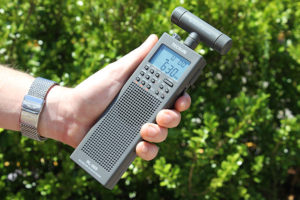
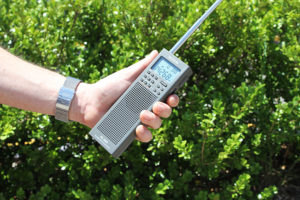
Thanks to Radio Jay for this review very detailed review. Read the full review here.
Garry VK2YBX has prepared some great tips and tricks for using the Tecsun PL365. You can read them here.
Treat yourself to a great new radio today. Buy the PL365 now.
The Tecsun PL680 has been a long time coming to the Australian market so we’re very excited that Silicon Chip Magazine has featured this great new addition to our range of radios in their most recent December 2015 magazine’s Product Showcase.
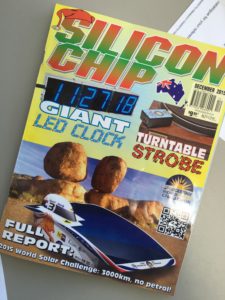
The Tecsun PL680 is featured in Silicon Chip Magazine December 2015
“For keen shortwave listeners, you’ll notice the difference in the PL680.”
– Silicon Chip Magazine
And the Silicon Chip team aren’t the only ones excited about the upgrades. Here are just a few other reviews the PL680 has received:
“Worth the upgrade.”
“Tecsun certainly gives you a lot of bang for your buck.”
– Chris Freitas, On Radio Blog
The PL680 was featured and reviewed in Silicon Chip Magazine alongside the new Tecsun PL365 giving two of our most popular portable receivers a major makeover, making them even better value for money.
The PL680 radio with VHF Air Band is a great radio for communications enthusiasts with the radio providing excellent reception to all of the major frequency bands including AM/MW, FM, Shortwave with SSB, Longwave, and VHF Air Band.
The Tecsun PL365 is the only radio in the Tecsun range (apart from the Tecsun S2000 Desktop Radio) to provide an external antenna connection for the AM/MW band. The Tecsun PL365 Radio is an ideal radio to use for AM/MW EMI surveys because of its external AM antenna, ability to accept customised antennas and display showing signal strength in dBuV.
Both radios are available and in stock now, right in time for Christmas.




